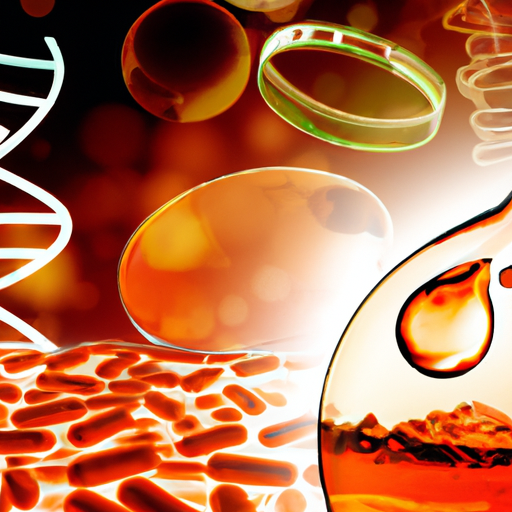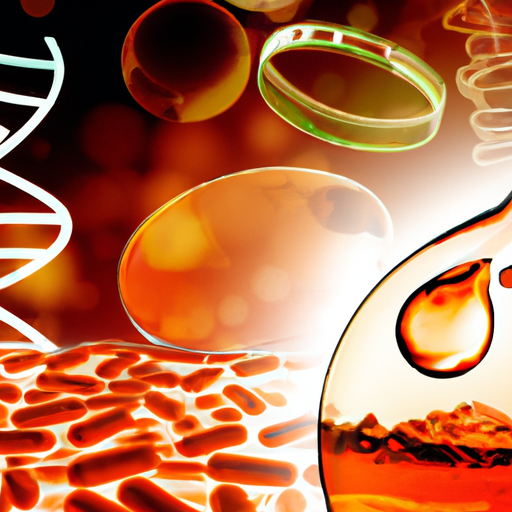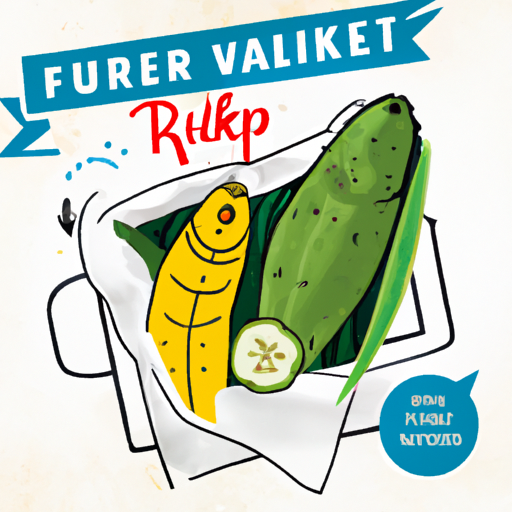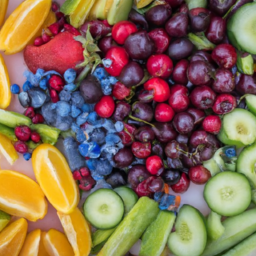Trends In Food Science & Technology
In the world of food science and technology, constant evolution is key. From innovative ingredients to cutting-edge techniques, the industry is always in motion. This article explores the latest trends in food science and technology, offering a glimpse into the exciting advancements that are shaping the way we eat and enjoy our food. Discover how scientific research is revolutionizing the culinary landscape, and gain insights into the transformative power of technology in the realm of food. Get ready to explore the fascinating world of food science and technology.
Table of Contents
Trends in Food Science & Technology
Food science and technology is an ever-evolving field that constantly seeks to improve and innovate how we produce, preserve, and consume food. In recent years, there have been several notable trends that have emerged, shaping the future of the food industry. From advancements in food processing and preservation techniques to the introduction of cutting-edge technologies, these trends are revolutionizing the way we approach food. In this article, we will explore ten key trends in food science and technology and delve into the exciting developments that are transforming the industry.

1. Innovations in Food Processing
The field of food processing has experienced significant advancements, driven by the need to improve efficiency, safety, and quality. One such innovation is the use of High-Pressure Processing (HPP). HPP employs high levels of pressure to inactivate harmful microorganisms and extend the shelf life of food products without the use of heat. This method retains the nutritional value, flavor, and texture of the food, making it an attractive option for both consumers and manufacturers.
Incorporating nanotechnology into food processing is another promising trend. Nanotechnology involves manipulating and controlling materials at the nanoscale level, allowing for the creation of functional food materials with enhanced properties. This technology enables the development of nanoencapsulation, which improves the stability and bioavailability of bioactive compounds, as well as the creation of nanosensors for rapid food quality monitoring.
The development of intelligent packaging is another noteworthy trend in food processing. Intelligent packaging incorporates sensors and indicators that can monitor various aspects of the food, such as temperature, moisture, and gas levels. This technology not only helps ensure the quality and safety of the food but also provides consumers with valuable information on product freshness and storage conditions.
Utilization of cold plasma technology is yet another exciting development in food processing. Cold plasma, a state of matter generated by applying an electric field to a low-pressure gas, has antimicrobial properties that can effectively eliminate pathogens on the surface of food products. This technology offers a non-thermal alternative to traditional methods, preserving the sensory and nutritional properties of food while ensuring safety.
2. Advances in Food Preservation
Preserving food is crucial for extending its shelf life, reducing food waste, and ensuring that it remains safe for consumption. To address these challenges, several advances in food preservation techniques have emerged.
The implementation of novel preservation techniques, such as high-pressure processing, pulsed electric fields, and pulsed light technology, has gained traction. These methods allow for the preservation of food without the use of chemical additives or excessive heat, preserving the nutritional integrity and quality of the products.
Advancements in natural preservatives have also been a focus of research and development. Natural preservatives derived from plants, such as essential oils and extracts, have antimicrobial properties that can inhibit the growth of spoilage organisms. These natural alternatives are gaining popularity as consumers seek healthier and more sustainable options.
The application of biopreservation methods is another trend in food preservation. Biopreservation involves the use of beneficial bacteria, yeasts, or enzymes to inhibit the growth of harmful microorganisms and extend the shelf life of food. This approach is particularly appealing as it offers a natural and eco-friendly alternative to traditional preservation methods.
Non-thermal processing techniques, such as high-pressure processing, pulsed electric fields, and ultrasound, are also gaining recognition for their ability to preserve food while minimizing the impact on its sensory and nutritional quality. These methods use non-thermal energy sources to inactivate microorganisms and enzymes, ensuring food safety and extending shelf life.
3. Emerging Food Safety Technologies
Ensuring food safety is of paramount importance to both consumers and the food industry. In recent years, several emerging technologies have been adopted to enhance food safety and mitigate risks.
The adoption of sensor-based detection systems is transforming the way we detect and identify contaminants in food. These systems employ various sensors, such as optical, electrochemical, and biosensors, to rapidly and accurately detect pathogens, allergens, and chemical contaminants. This technology enables quick and efficient monitoring of food safety throughout the supply chain.
Blockchain technology is also making waves in the realm of food safety. Blockchain is a distributed ledger system that allows for transparent and secure record-keeping. By integrating blockchain into the food supply chain, it becomes possible to track and trace the entire journey of a food product, from farm to fork, ensuring transparency and accountability.
The utilization of rapid microbiology testing is another advancement in food safety. Rapid microbiology testing methods, such as polymerase chain reaction (PCR) and next-generation sequencing (NGS), provide rapid and accurate identification of microorganisms, allowing for faster response to potential foodborne outbreaks and reducing the risk of foodborne illnesses.
The introduction of food safety management systems, such as Hazard Analysis and Critical Control Points (HACCP), has revolutionized the way food safety is managed. These systems provide a systematic approach to identifying and controlling hazards throughout the production process, ensuring the safety and quality of food products.
4. Sustainable and Plant-Based Alternatives
As sustainability and environmental concerns continue to gain prominence, the food industry is witnessing a shift towards sustainable and plant-based alternatives. These alternatives not only offer ecological benefits but also cater to the growing demand for healthier and more ethical food choices.
The growing demand for plant-based proteins is a significant trend in the food industry. Plant-based protein sources, such as legumes, pulses, and nuts, are gaining popularity as viable substitutes for animal-based proteins. These plant-based proteins are not only environmentally friendly but also offer health benefits, such as lower cholesterol and reduced risk of certain diseases.
The development of sustainable packaging materials is another important aspect of promoting sustainability in the food industry. Innovations in packaging materials, such as biodegradable plastics, compostable materials, and plant-based alternatives, are reducing the environmental impact of packaging waste and contributing to a more sustainable future.
Utilizing food waste for value-added products is another trend aimed at reducing food waste and promoting sustainability. By repurposing food waste into ingredients or products, such as biofuels, animal feed, or fertilizers, the industry can minimize waste and generate additional value from resources that would otherwise be discarded.
Promoting sustainable farming practices is also crucial in achieving a more sustainable food system. Practices such as regenerative agriculture, organic farming, and precision agriculture can reduce the environmental impact of agriculture, conserve natural resources, and promote biodiversity.
5. Functional Foods and Nutraceuticals
Functional foods, which provide health benefits beyond basic nutrition, are gaining significant attention as consumers prioritize their well-being. As a result, the development of functional ingredients and the incorporation of probiotics and prebiotics into food products have become major trends in food science and technology.
Research on bioactive compounds and their potential health benefits is a rapidly growing field within food science. Bioactive compounds, such as antioxidants, polyphenols, and phytochemicals, have been associated with various health benefits, including antioxidant and anti-inflammatory properties. Investigating the effects of these compounds and incorporating them into food products allows for the creation of functional foods that can promote health and prevent diseases.
The formulation of functional ingredients is a key step in the development of functional foods. Functional ingredients, such as Omega-3 fatty acids, dietary fibers, and plant sterols, can be incorporated into various food products to enhance their nutritional profile and health benefits. These ingredients can improve heart health, support digestion, and boost the immune system, among other benefits.
The use of probiotics and prebiotics is another important trend in functional foods. Probiotics are live microorganisms that confer health benefits when consumed, while prebiotics are nondigestible carbohydrates that selectively stimulate the growth of beneficial gut bacteria. Incorporating probiotics and prebiotics into food products, such as yogurts and cereals, can improve digestive health and enhance overall well-being.
Incorporation of nutrient delivery systems is another area of focus in functional foods. Nutrient delivery systems, such as encapsulation and delivery vehicles, allow for the targeted delivery of bioactive compounds and nutrients, ensuring their optimal absorption and efficacy within the body.
6. Impact of Artificial Intelligence
Artificial Intelligence (AI) is rapidly transforming various industries, and the food industry is no exception. AI-driven technologies are being employed to automate processes, optimize supply chain management, enhance quality control processes, and personalize consumer experiences.
Automation of food processing operations is revolutionizing the industry by streamlining production processes and reducing labor costs. AI-powered robots and automated systems can perform tasks such as sorting, packing, and quality control with greater efficiency and accuracy, significantly improving productivity.
Optimization of supply chain management is another area where AI is making a significant impact. AI algorithms can analyze vast amounts of data, such as inventory levels, demand patterns, and transportation routes, to optimize supply chain operations and reduce waste. This technology ensures a more efficient and responsive supply chain, minimizing food losses and improving overall operational performance.
Enhancement of quality control processes through AI is improving product safety and consistency. AI systems can analyze data from sensors and cameras to detect defects, contaminants, or deviations in production, ensuring that only high-quality products reach the market.
Personalization of consumer experiences is another notable trend driven by AI. Through AI-enabled platforms and applications, food companies can gather and analyze consumer data to customize offerings, recommend personalized diets or recipes, and provide tailored nutritional advice. This personalized approach enhances customer satisfaction, loyalty, and overall well-being.
7. Technology-Driven Culinary Innovations
The fusion of technology and culinary arts has given rise to exciting innovations that are revolutionizing the way we cook, serve, and experience food. From 3D printing in food to augmented and virtual reality experiences, these advancements are transforming the culinary landscape.
The development of 3D printing in food is a game-changer, allowing for the creation of complex and customized food structures. 3D printers can use edible materials, such as chocolate or dough, to build intricate shapes and designs, enabling chefs to unleash their creativity and customize food presentation.
Augmented reality (AR) is being utilized to enhance food experiences by overlaying digital information or virtual objects onto the real world. AR applications can provide interactive menus, nutritional information, or virtual cooking demonstrations, enhancing the dining experience and engaging consumers in a unique way.
Virtual reality (VR) is finding its place in culinary education, offering immersive learning experiences for aspiring chefs. VR simulations allow culinary students to practice cooking techniques, experiment with flavors, and learn in a virtual kitchen environment. This technology provides a safe and cost-effective way to train future chefs and explore culinary creativity.
Innovation in cooking techniques and equipment is continuously pushing the boundaries of culinary arts. From precision induction cookers to sous vide machines, these advancements offer precise temperature control, reduce cooking times, enhance flavor development, and open up new possibilities for culinary creativity.
8. Diversity and Global Fusion of Flavors
As the world becomes more interconnected, the diversity and fusion of flavors from different culinary traditions are becoming increasingly prevalent. Food enthusiasts and adventurous eaters are seeking unique and multicultural culinary experiences, leading to the introduction of international ingredients, fusion cuisine, and the utilization of ethnic cooking techniques.
The introduction of international ingredients into mainstream food culture has broadened culinary horizons and exposed consumers to new flavors and ingredients. Exotic spices, unfamiliar fruits and vegetables, and unique condiments are finding their way into recipes and menus, allowing people to explore and appreciate the diverse culinary heritage of different cultures.
The fusion of different culinary traditions is another notable trend in the food industry. Chefs and food enthusiasts are experimenting with the blending of flavors, techniques, and ingredients from different cuisines, creating exciting fusion dishes that showcase the best of multiple culinary worlds. This trend celebrates diversity and offers new and unexpected taste experiences.
Utilization of ethnic cooking techniques is also gaining popularity, as they bring unique flavors and textures to the table. Techniques such as Chinese stir-frying, Indian tandoori grilling, or Mexican mole sauce preparation are finding their way into mainstream cooking, adding depth and authenticity to dishes.
Promotion of cultural food experiences is an important aspect of fostering appreciation and understanding of different culinary traditions. Food events, festivals, and culinary tours that highlight the rich cultural heritage of different cuisines provide opportunities for people to learn, taste, and celebrate global flavors.
9. Precision Nutrition and Personalized Diets
The concept of precision nutrition and personalized diets is gaining traction as a way to optimize health and well-being. By utilizing advancements in nutrition science and technology, tailored dietary approaches are being developed to meet individual needs and goals.
Utilization of nutrigenomics is an emerging field within nutrition science that focuses on the interaction between genes and nutrients. By analyzing an individual’s genetic profile, personalized dietary recommendations can be made to optimize health outcomes and reduce the risk of chronic diseases.
Tailored dietary approaches, such as personalized meal plans and nutritional coaching, are gaining popularity as people recognize the importance of individualized nutrition. These approaches take into account factors such as age, sex, activity level, health conditions, and personal goals to create customized dietary recommendations that meet specific needs.
The application of wearable devices for nutrition tracking is another trend shaping precision nutrition. Wearable devices, such as fitness trackers or smartwatches, can monitor various parameters related to nutrition, including calorie intake, macronutrient balance, hydration status, and physical activity. This data can then be used to provide real-time feedback, track progress, and fine-tune dietary recommendations for optimal health.
Integration of artificial intelligence for nutritional analysis is another area where technology is making an impact. AI algorithms can analyze dietary patterns, nutrient composition, and health data to provide personalized insights and recommendations. This technology enables individuals to make informed decisions about their diet and track progress towards their health goals more effectively.
10. Consumer Demand for Clean Label Products
As consumers become more health-conscious and aware of the ingredients in their food, there is a growing demand for clean label products. Clean label refers to food products that are made with minimal processing, simple and recognizable ingredients, and no artificial additives.
The growing interest in natural and organic foods is driving the demand for clean label products. Consumers are seeking foods that are free from synthetic chemicals, pesticides, hormones, and genetically modified organisms (GMOs). Natural and organic food labels provide assurance that the products meet these criteria and align with consumer preferences.
Rising preference for simple ingredients is another factor shaping the clean label trend. Consumers are increasingly concerned about the quality and sourcing of ingredients in their food. They look for products that have a short ingredient list, with recognizable and minimally processed ingredients.
Demand for transparency in food labels is also driving the clean label movement. Consumers want to know where their food comes from, how it is produced, and what ingredients are used. Manufacturers are responding by providing detailed information on product labels, including sourcing practices, certifications, and nutritional content.
Focus on clean and sustainable food production is another aspect of the clean label trend. Consumers are concerned about the environmental impact of food production, including factors such as water usage, carbon emissions, and waste generation. They seek products from companies that prioritize sustainability, eco-friendly packaging, and ethical sourcing practices.
In conclusion, the field of food science and technology is experiencing exciting advancements and trends that are shaping the future of the food industry. From innovations in food processing and preservation to the adoption of cutting-edge technologies, these trends are revolutionizing how we produce, preserve, and consume food. As sustainability, health-consciousness, and personalization remain key concerns for consumers, the industry will continue to explore new avenues to meet these demands. These trends offer immense potential to create a more sustainable, nutritious, and enjoyable food system for all.






